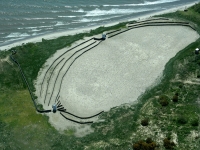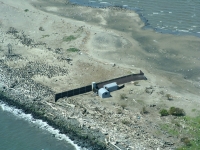 2011 Final Annual Report
2011 Final Annual Report
We conducted field studies in 2011 to (1) assess the impact of avian predation on survival of juvenile salmonids (Oncorhynchus spp.) in the Columbia River estuary, (2) monitor the efficacy of on-going Caspian tern (Hydroprogne caspia) management actions designed to reduce their impact on salmonid smolt survival in the estuary, (3) test management strategies to limit nesting habitat availability for double-crested cormorants (Phalacrocorax auritus) at East Sand Island in the Columbia River estuary, and (4) evaluate the impacts on smolt survival of piscivorous colonial waterbirds (i.e., Caspian terns, double-crested cormorants, American white pelicans [Pelecanus erythrorhynchos], California gulls [Larus californicus], and ring-billed gulls [L. delawarensis]) that nest in the Columbia Plateau region.
The Caspian tern colony on East Sand Island, the largest of its kind in the world, consisted of about 7,000 breeding pairs in 2011, a decline from 2010 (ca. 8,300 breeding pairs). The Caspian tern colony on East Sand Island did not produce a single fledgling in 2011, the first time that a complete breeding failure has been recorded at this colony. The proximal factors responsible for colony failure and the decline in colony size were intense disturbance by bald eagles (Haliaeetus leucocephalus) and associated gull predation on tern eggs and chicks. Climate conditions associated with a very strong La Niña and the resultant exceptionally high river flows also apparently contributed to the lack of nesting success through their effects on marine forage fish availability.
Juvenile salmonids continued to be a large part of the diet of Caspian terns nesting on East Sand Island, comprising 36% of the diet (percent of prey items) in 2011, somewhat higher than the average during 2000-2010 (30%). Despite complete colony failure, Caspian terns nesting at the East Sand Island colony consumed about 4.8 million juvenile salmonids (95% c.i. = 4.0 – 5.6 million) in 2011, lower than the 11-year average but not significantly different than the smolt consumption estimates from the previous two years. Further reductions in smolt consumption by Caspian terns nesting on East Sand Island will require further reductions in the size of the tern colony; future management plans are designed to reduce the size of the East Sand Island tern colony to about one-third its pre-management size (ca. 9,500 breeding pairs).
 |
Data on diet composition of Caspian terns nesting at colonies in interior Oregon and northeastern California indicated that in 2011 these colonies were primarily consuming cyprinids (i.e., chub Gila spp.), centrarchids (i.e., crappie Pomoxis spp.), and ictalurids (i.e., bullhead Ameiurus spp.). Catostomids (suckers), several species of which are listed under the Endangered Species Act, were not identified in the diet of terns nesting in interior Oregon (i.e., Crump Lake and Summer Lake) during 2011. Two juvenile suckers (species unknown) were observed at two Caspian tern colonies in northeastern California (i.e., Sheepy Lake and Tule Lake Sump 1B) during 2011. Suckers represented a very small percentage (< 0.1%) of identifiable prey items at these two tern colonies. No sucker PIT tags were recovered from Caspian tern colonies in either interior Oregon or northeastern California during 2011.
East Sand Island in the Columbia River estuary is also home to the largest double-crested cormorant colony in western North America, which consisted of about 13,000 breeding pairs in 2011, very similar to 2010 (ca. 13,600 breeding pairs). Juvenile salmonids represented about 19% of the diet (percent biomass) of double-crested cormorants nesting on East Sand Island in 2011, the highest percentage observed since 1999 (24.6% of the diet). Double-crested cormorants nesting at the East Sand Island colony consumed approximately 20.5 million juvenile salmonids (95% c.i. = 15.2 – 25.9 million) in 2011, the highest annual point estimate of smolt consumption for the East Sand Island cormorant colony so far recorded. During the past two years, smolt consumption by double-crested cormorants nesting on East Sand Island has been significantly greater than smolt consumption by Caspian terns nesting on East Sand Island.
 |
Further up-river in the Columbia Plateau region, Caspian terns and double-crested cormorants are also the two bird species responsible for most of the smolt losses to avian predators. Management options to reduce the impacts of these two avian predators on smolt survival along the mid-Columbia River and lower Snake River are currently being considered by resource managers. In 2011, the largest breeding colonies of Caspian terns in the Columbia Plateau region were at Crescent Island on the mid-Columbia River (in McNary Pool) and on Goose Island on Potholes Reservoir (near Othello, WA), where nearly equal numbers of breeding pairs (ca. 420) nested in 2011. Caspian tern nesting success at both colonies in 2011 was also similar (ca. 0.3 young raised per nesting pair). During the 2011 breeding season, salmonid smolts represented 84% of tern prey items at the Crescent Island colony, the highest percentage ever recorded at that colony, and 24% of tern prey items at the Goose Island/Potholes colony. Estimated consumption of juvenile salmonids by Caspian terns nesting at these two colonies was 440,000 smolts and 111,000 smolts, respectively.
The largest colony of double-crested cormorants on the mid-Columbia River was on Foundation Island in McNary Pool, where about 318 pairs nested in 2011. Diet sampling during 2005-2010 indicated that ca. 50% (by mass) of the diet of Foundation Island cormorants was juvenile salmonids during May (the peak of smolt out-migration), while less than 10% of the cormorant diet was salmonids during early April, June, and July. Using diet data collected during 2005-2010, and data on colony size and productivity in 2011, we estimated that Foundation Island cormorants consumed 24,700 kg of juvenile salmonids (95% c.i. = 19,100 – 30,300 kg) in 2011. As in previous years, this was significantly greater than salmonid consumption by the Crescent Island Caspian tern colony (14,700 kg in 2011; 95% c.i. = 12,200 – 17,200 kg).
An estimated 36,918 PIT tags from 2011 migration year salmonid smolts were deposited by birds on their nesting colonies in the Columbia Plateau region. PIT tag recoveries indicated that smolt losses in 2011 were highest due to Crescent Island Caspian terns (11,734 PIT tags), followed by Foundation Island double-crested cormorants (8,376 PIT tags) and Goose Island Caspian terns (6,387 PIT tags). PIT tags recovered from the Caspian tern colony on Goose Island in Potholes Reservoir were almost exclusively from upper Columbia River salmonid evolutionarily significant units (ESUs) or distinct population segments (DPSs), while PIT tags recovered on other bird colonies in the Columbia Plateau region consisted of smolts from Upper Columbia, Snake, and Middle Columbia ESUs or DPSs. PIT tag recovery results indicate that Caspian terns from the Goose Island colony in Potholes Reservoir consumed an estimated 8.9% of the ESA-listed steelhead (O. mykiss) smolts that were PIT-tagged and detected/released at Rock Island Dam on the upper Columbia River, the highest ESU-specific predation rate measured in 2011 for birds nesting at a colony in the Columbia Plateau region. Predation rates by Crescent Island terns on Snake River steelhead (ca. 1.9%) and by Foundation Island cormorants on Snake River steelhead (ca. 1.8%) were also notable in 2011 and comparable to those reported in previous years (2007-2010). Predation on salmonid smolts by American white pelicans nesting on Badger Island and California and ring-billed gulls nesting on Crescent Island and Miller Rocks during 2011 were relatively minor (generally < 0.5% per ESU or DPS) in comparison to that of Caspian terns and double-crested cormorant nesting at colonies in the Columbia Plateau region.
California and ring-billed gulls nest in large numbers on islands on or near the mid- and upper Columbia River, but these gulls have generally consumed few fish and even fewer juvenile salmonids compared to Caspian terns or double-crested cormorants nesting along the mid-Columbia River. In 2011, the number of gulls counted on the Miller Rocks colony was 5,750, up slightly from the 5,533 gulls counted on the colony during the 2010 breeding season. The number of gulls nesting on Miller Rocks has apparently increased by about 160% since 1998. Similarly, the American white pelican colony on Badger Island in McNary Pool has undergone dramatic growth since the late 1990’s, increasing from ca. 100 adults on-colony in 1999 to ca. 2,200 adults on-colony in 2011. The numbers of smolt PIT tags recovered from both the Miller Rocks gull colony and the Badger Island pelican colony have increased commensurate with increases in colony size.
- Bird Research Northwest
Click here to view the complete report



